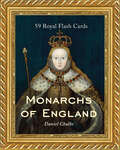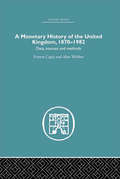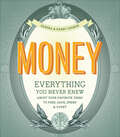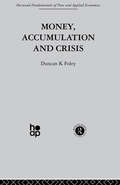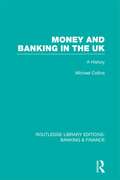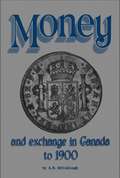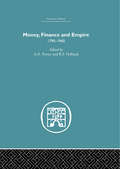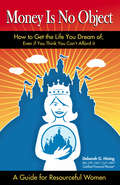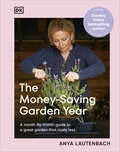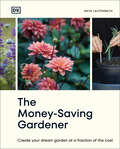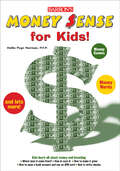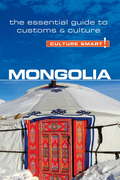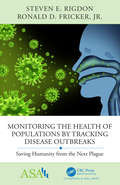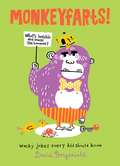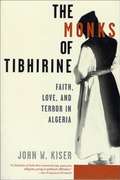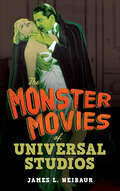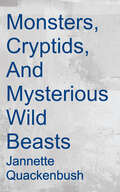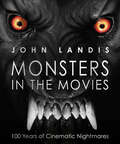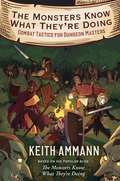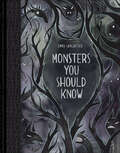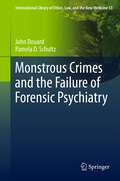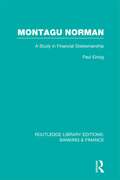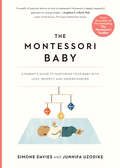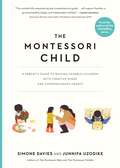- Table View
- List View
Monarchs of England: 59 Royal Flashcards
by Daniel ChalkeRoyal portraits and fast historical facts on rulers from King Athelstan to Queen Elizabeth II. Whether famed like Queen Victoria or a bit more obscure like King Sweyn Forkbeard, this collection tells a story that spans more than a thousand years, showcasing the fifty-nine English monarchs who preceded King Charles. It features portraits from prestigious galleries like the National Portrait Gallery in London, each a beautiful, miniature work of art set in an elegant gilt frame, paired with fascinating details of the monarch&’s reign. Perfect for reference, study, or an entertaining browse through history, Monarchs of England makes learning about the English monarchy a visual treat.
A Monetary History of the United Kingdom: 1870-1982
by Forrest Capie Alan WebberThis book is the culmination of a major research programme on the monetary history of the United Kingdom. This volume contains monetary series ranging from detailed balance sheet material to monetary aggregates such as M3 and are in monthly, quarterly and annual form. The data are drawn mostly from primary sources in the early part of the period and from more accessible published sources for more recent years. Critiques of existing series are given and assessments of the value of different sources are provided. The user should be able to build his/her own series from the basic constituents given here. This sources and assessment of data should be an essential reference to economic historians and applied economists with an interest and use to the students of money and banking and to monetary economists of other countries. This classic book was first published in 1985.
Money: Everything You Never Knew About Your Favorite Thing to Find, Save, Spend & Covet
by Sandra Choron Harry ChoronA lively, illustrated, trivia-packed volume about the subject that makes the world go round.Ever made a fast buck? How about traded cowrie shells for a bride or paid for gum with a $10,000 bill? This entertaining and information-packed miscellany explains our fascination with money and how it has shaped our world.Vintage photographs and artwork illustrate surprising facts, lists, and trivia about forgotten financial catastrophes and famous bank robbers, the history of bankruptcy and ancient money gods, wacky cash-related slang and get-rich-quick schemes for the ages. Witty and comprehensive, this valuable volume explores dollars and cents, pounds and pence, and the countless other forms of money.
Money, Accumulation and Crisis (Fundamentals Of Pure And Applied Economics Ser. #Vol. 2)
by D. FoleyDuncan Foley provides an alternative to Keynesian and 'new classical' macroeconomics, based on the Marxian theory of capital.
Money and Banking in the UK: A History (Routledge Library Editions: Banking & Finance)
by Michael CollinsThis book is concerned with developments in three main areas of monetary history: domestic commercial banking; monetary policy; and the UK’s international financial position. For ease of analysis the 160 years under study are arranged into three clear chronological divisons. Part 1 covers the years 1826-1913, a period in which the UK emerged as the world’s leading economic power. It was in these years that an extensive and fully-operative domestic banking system was established. Part 2 covers 1914 to 1939 – the years which marked a break in the traditional monetary arrangements of the Victorian and Edwardian eras. Part 3 covers 1939-1986 when the dominance of state influence within the domestic money markets was re-established by the Second World War and the acceptance by the authorities of the obligation to ‘manage’ the economy which meant that successive postwar governments took direct responsibility for the conduct of monetary and credit policy.
Money and Exchange in Canada to 1900
by A. B. McCulloughOf special interest to coin and bill collectors, as well as history buffs and students, is this clear, concise and intriguing explanation of the various coins and currencies used in Canada between 1600 and 1900. Covering the French, British, and Canadian periods of our history, the wide range of currencies used is explained: livres, pounds, playing cards, louis d’ors, eagles, shillings and dollars among others. Divided into geographical sections, each area of Canada, from Newfoundland to the West, the ever-changing conditions of money and exchange is covered in detail. The concluding chapter brings together each of these threads and weaves a unified picture of the early Canadian monetary system. Aided by a generous selection of illustrations, figures and tables, A.B. McCullough has written a comprehensive guide to our monetary history that is both useful and interesting.
Money Banking And International Trade - Thirteenth Revised Edition
by Dr R. R. Paul"MONEY BANKING AND INTERNATIONAL TRADE" by Dr. R.R. Paul provides a comprehensive exploration of the evolution and functions of money, the intricacies of banking systems, and the dynamics of international trade. The book is divided into four main sections: Money, Banking, Income and Employment Theory, and International Trade. It traces the development of money from the barter system to modern monetary standards, detailing the roles and significance of money in economic systems. The banking section delves into the operations and structures of commercial and central banking, with a focus on the Indian context. The book also discusses economic theories related to income and employment, such as national income and the consumption function. The international trade section covers classical and modern theories, the balance of payments, foreign exchange, and global financial institutions. Throughout, the author incorporates updated facts and recent developments, making it a valuable resource for students and educators in economics.
Money, Finance and Empire: 1790-1960
by A.N. Porter R.F. HollandThis book was first published in 1985.
Money is No Object: How to Get the Life You Dream of Even if You Think You Can't Afford It
by Deborah G. HiningThis book guides women on an adventure that will help them achieve their greatest desires, even when all reason says they could never afford it. Most importantly, it leaves women understanding how fabulously wealthy they really are -- no matter how much, or how little, they have in their checking account.
The Money-Saving Garden Year: A Month-by-month Guide to a Great Garden that Costs Less
by Anya LautenbachGarden better for less all year long with Anya Lautenbach the “Money-Saving Gardener”. With month-by-month advice on what to do when – from self-sown seedlings to spot, the best time to propagate different plants, and seasonal pruning jobs – Anya shows you how to keep your garden looking good without breaking the bank. Handy monthly plant lists, money-saving tips, propagation chart, and planting calendar guide you on your way. Embrace each season with timely projects to absorb you, garden highlights to enjoy, and notes on how to find happiness in your garden even in the depths of winter. Anya’s clear, practical yet mindful approach will help anyone grow a glorious garden while cutting costs.
The Money-Saving Gardener: Create Your Dream Garden at a Fraction of the Cost
by Anya LautenbachBeat the rising cost of living and transform your garden on a budget with Anya the Garden Fairy.The Money-Saving Gardener reveals the tips and tricks to keeping costs down without compromising on style or impact. Learn how to repurpose what you have and give new life to second-hand garden furniture; discover savvy cheats to keep hard landscaping costs low; and boost your plant collection for next to nothing with seed-saving and propagation hacks. Revealing the plants that will give you the best long-term value for money, tips for choosing the varieties that will thrive in your garden year after year, and projects for making the most of your propagated cuttings and seedlings, The Money-Saving Gardener proves that a stunning garden doesn&’t need to cost the earth or break the bank.
Money Sense for Kids!
by Hollis Page HarmanThe perfect book for learning about money for kids! Discover how boys and girls can find savings programs designed especially for them, how can they establish their own bank account, write checks, and use an ATM card. Also find out how kids learn about stocks, and even start to invest their own money! Readers will find out:How and where money is printed?What do all those long numbers and special letters on currency mean?How can banks afford to pay interest?This helpful book offers ideas on how kids can earn, save, budget, and invest money of their own. Also offered are puzzles and games that focus on the theme of money. Color diagrams and illustrations are on nearly every page.
Mongolia - Culture Smart!
by Alan SandersMongolia is landlocked between its neighbors China and Russia in the heart of Asia. For centuries after the disintegration of Genghis Khan's empire it was ruled by one or the other, but in 1990 the Mongols embraced democracy. Now, after two centuries of Manchu stagnation and seventy years of Soviet communism, they are rebuilding their national heritage. Rarely in the news but making progress toward a market economy, this resource-rich but infrastructure-poor country is a land of pioneers, and its greatest asset is the Mongol people, who are friendly, cooperative, ambitious, and well educated. English is now the first foreign language and the country's leaders are forging new partnerships with international investors. Travelers from across the world are drawn to the "land of blue sky" by its picturesque mountains and lakes, flower-carpeted steppes and stony deserts, home to the snow leopard, the wild horse and camel, and the Gobi bear. The broad pasturelands, with herds of grazing livestock, and the traditional lifestyle of the nomads contrast with the busy streets of the capital Ulan Bator, a bustling metropolis of over one million people, modern hotels, apartments, and shops, interspersed with Buddhist monasteries and temples, surrounded by crowded suburbs of traditional felt tents. Mongolia's many attractions range from dinosaur skeletons and the remains of ancient civilizations to relics and reenactments of the Genghis Khan era, and the traditional sports of wrestling, archery, and horse-racing. Culture Smart! Mongolia provides rare insights into contemporary Mongolian society, and offers practical tips on what to expect and how to conduct yourself in order to get the most out of your visit. Despite the undeniable challenges posed by modernity, these warm, tough, adaptable, and hospitable people welcome visitors and are open to the world.
Monitoring the Health of Populations by Tracking Disease Outbreaks: Saving Humanity from the Next Plague (ASA-CRC Series on Statistical Reasoning in Science and Society)
by Steven E Rigdon Ronald D. Fricker, Jr.With COVID-19 sweeping across the globe with near impunity, it is thwarting governments and health organizations efforts to contain it. Not since the 1918 Spanish Flu have citizens of developed countries experienced such a large-scale disease outbreak that is having devastating health and economic impacts. One reason such outbreaks are not more common has been the success of the public health community, including epidemiologists and biostatisticians, in identifying and then mitigating or eliminating the outbreaks. Monitoring the Health of Populations by Tracking Disease Outbreaks: Saving Humanity from the Next Plague is the story of the application of statistics for disease detection and tracking. The work of public health officials often crucially depends on statistical methods to help discern whether an outbreak may be occurring and, if there is sufficient evidence of an outbreak, then to locate and track it. Statisticians also help collect critical information, and they analyze the resulting data to help investigators zero in on a cause for a disease. With the recent outbreaks of diseases such as swine and bird flu, Ebola, and now COVID-19, the role that epidemiologists and biostatisticians play is more important than ever. Features: · Discusses the crucial roles of statistics in early disease detection. · Outlines the concepts and methods of disease surveillance. · Covers surveillance techniques for communicable diseases like Zika and chronic diseases such as cancer. · Gives real world examples of disease investigations including smallpox, syphilis, anthrax, yellow fever, and microcephaly (and its relationship to the Zika virus). Via the process of identifying an outbreak, finding its cause, and developing a plan to prevent its reoccurrence, this book tells the story of how medical and public health professionals use statistics to help mitigate the effects of disease. This book will help readers understand how statisticians and epidemiologists help combat the spread of such diseases in order to improve public health across the world.
Monkeyfarts!: Wacky Jokes Every Kid Should Know
by David BorgenichtFrom classic favorites to zany newcomers, Monkeyfarts! is packed to bursing with wild and wacky jokes about monsters, pirates, polar bears, super-heroes, hot dogs, Harry Potter, Vikings, elephants, vampires, and more. With hilarious jokes and bold illustrations, it's the only joke book you'll ever need. Who doesn't love Monkeyfarts!?
The Monks of Tibhirine: Faith, Love, and Terror in Algeria
by John W. KiserBack Cover: "In the spring of 1996 armed men broke into a Trappist monastery in war-torn Algeria and took seven monks hostage. pawns in a murky negotiation to free imprisoned terrorists. Two months later the monks' severed heads were found in a tree; their bodies were never recovered. The village of Tibhirine had sprung up around the monastery because it was a holy place protected by the Virgin Mary, revered by Christians and Muslims alike. But napalm. helicopters, and gunfire had become regular accompaniments to the monastic routine as the violence engulfing Algeria drew closer to the isolated cloister high in the Atlas Mountains." The author shows the different shades of Islam and how Christians and Moslems can live in harmony if they are given the correct set of conditions.
The Monster Movies of Universal Studios
by James L NeibaurThis history and critique of classic scary films &“honors Universal&’s horror legacy. . . . an excellent resource for film students and monster movie fanatics&” (Library Journal). In 1931 Universal Studios released Dracula starring Bela Lugosi. This box office success was followed by a string of films featuring macabre characters and chilling atmospherics, including Frankenstein, The Mummy, and The Invisible Man. With each new film, Universal established its place in the Hollywood firmament as the leading producer of horror films, a status it enjoyed for more than twenty years. In The Monster Movies of Universal Studios, James L. Neibaur examines the key films produced by the studio from the early 1930s through the mid-1950s. In each entry, Neibaur recounts the movie&’s production, provides critical commentary, considers the film&’s commercial reception, and offers an overall assessment of the movie&’s significance. Neibaur also examines the impact these films had on popular culture, an influence that resonates in the cinema of fear today. From the world premiere of Dracula to the 1956 release of The Creature Walks among Us, Universal excelled at scaring viewers of all ages—and even elicited a few chuckles along the way by pitting their iconic creatures against the comedic pair of Abbott and Costello. The Monster Movies of Universal Studios captures the thrills of these films, making this book a treat for fans of the golden age of horror cinema. &“Studio stills and trade ads for several of the films add a suitably scary touch to this treat for fans and scholars alike. ― Booklist &“An impressive work of film scholarship.&” ― Cinema Retro
Monsters, Cryptids, And Mysterious Wild Beasts: West Virginia, Ohio, Maryland And Beyond. And Where To Find Them
by Jannette Quackenbush 21 Crows Dusk To Dawn PublishingMonsters, Cryptids, and Mysterious Wild Beasts - Discover the stories behind Ohio, West Virginia, and Maryland's most incredible creatures! Bigfoot. Goatman. Frogmen. Black Dogs. Sheepsquatch. Mothman. Flatwoods Monster. Dogman . . . In the autumn of 1952, a Flatwoods, West Virginia mom, her sons, and some neighborhood kids would come face to face with a 10-foot tall dark green figure with a reddish face that hovered above the ground alien-like. It both terrified and mystified them along with the rest of the country and would be called Flatwoods Monster . . . Find out more about the Flatwoods Monster and other mysterious things like a strange Bigfoot creature the author had a run-in with while checking out places for the book. PLACES/GPS of areas you can visit TO search for THESE WILD BEASTS. VISIT THE AREA THEY WERE SEEN! Pictures of areas!
Monsters in the Movies: 100 Years of Cinematic Nightmares
by John LandisFrom B-movie bogeymen and outer space oddities to big-budget terrors, Monsters in the Movies by legendary filmmaker John Landis showcases the greatest monsters ever to creep, fly, slither, stalk, or rampage across the Silver Screen! Landis provides his own fascinating and entertaining insights into the world of moviemaking, while conducting in-depth "conversations" with leading monster makers, including David Cronenberg, Christopher Lee, John Carpenter, and Sam Raimi — to discuss some of the most petrifying monsters ever seen. He also surveys the historical origins of the archetypal monsters, such as vampires, zombies, and werewolves, and takes you behind the scenes to discover the secrets of those special-effects wizards who created such legendary frighteners as King Kong, Dracula, and Halloween's Michael Myers. With more than 1000 stunning movie stills and posters, this book is sure to keep even the most intense fright-seekers at the edge of their seats for hours!
The Monsters Know What They're Doing: Combat Tactics for Dungeon Masters (The Monsters Know What They’re Doing #1)
by Keith AmmannFrom the creator of the popular blog The Monsters Know What They&’re Doing comes a compilation of villainous battle plans for Dungeon Masters.In the course of a Dungeons & Dragons game, a Dungeon Master has to make one decision after another in response to player behavior—and the better the players, the more unpredictable their behavior! It&’s easy for even an experienced DM to get bogged down in on-the-spot decision-making or to let combat devolve into a boring slugfest, with enemies running directly at the player characters and biting, bashing, and slashing away. In The Monsters Know What They&’re Doing, Keith Ammann lightens the DM&’s burden by helping you understand your monsters&’ abilities and develop battle plans before your fifth edition D&D game session begins. Just as soldiers don&’t whip out their field manuals for the first time when they&’re already under fire, a DM shouldn&’t wait until the PCs have just encountered a dozen bullywugs to figure out how they advance, fight, and retreat. Easy to read and apply, The Monsters Know What They're Doing is essential reading for every DM.
Monsters You Should Know
by Emma Sancartier&“A humorous—and richly illustrated—book full of quirky monsters. SanCartier&’s creatures are somehow both cute and terrifying.&” —USA Today Meet the world&’s most unusual monsters in this darkly funny collection of creatures and cryptids from folkloric history. Illustrator Emma SanCartier captures the bizarre and hilarious elements of seventeen monsters from around the world in a light, tongue-in-cheek tone, from the Japanese dream-eater Baku and the Persian carnivorous unicorn Shadhavar to the Eastern European Shurale, a literal tickle monster. Illustrated in lush watercolor, Monsters You Should Know is a perfect primer for the many strange, frightening, and compelling things that go bump in the night. &“An important book on monsters you should know about, mostly because it turns out they&’re really cute.&” —Buzzfeed
Monstrous Crimes and the Failure of Forensic Psychiatry
by John Douard Pamela D. SchultzThe metaphor of the monster or predator--usually a sexual predator, drug dealer in areas frequented by children, or psychopathic murderer--is a powerful framing device in public discourse about how the criminal justice system should respond to serious violent crimes. The cultural history of the monster reveals significant features of the metaphor that raise questions about the extent to which justice can be achieved in both the punishment of what are regarded as "monstrous crimes" and the treatment of those who commit such crimes. This book is the first to address the connections between the history of the monster metaphor, the 19th century idea of the criminal as monster, and the 20th century conception of the psychopath: the new monster. The book addresses, in particular, the ways in which the metaphor is used to scapegoat certain categories of crimes and criminals for anxieties about our own potential for deviant, and, indeed, dangerous interests. These interests have long been found to be associated with the fascination people have for monsters in most cultures, including the West. The book outlines an alternative public health approach to sex offending, and crime in general, that can incorporate what we know about illness prevention while protecting the rights, and humanity, of offenders. The book concludes with an analysis of the role of forensic psychiatrists and psychologists in representing criminal defendants as psychopaths, or persons with certain personality disorders. As psychiatry and psychology have transformed bad behavior into mad behavior, these institutions have taken on the legal role of helping to sort out the most dangerous among us for preventive "treatment" rather than carceral "punishment."
Montagu Norman: A Study in Financial Statemanship (Routledge Library Editions: Banking & Finance)
by Paul EinzigThis volume is not a biography of Montagu Norman (Governor of the Bank of England from 1920-1944). Rather it provides a comprehensive and balanced picture of his policy and work, and in particular the role Montagu Norman played behind the scenes in political developments. The book takes as one of its sources hitherto scarce material from Norman’s evidence before the Macmillan Committee which is reprinted in full in the appendices.
The Montessori Baby: A Parent's Guide to Nurturing Your Baby with Love, Respect, and Understanding
by Simone Davies Junnifa UzodikeIt&’s time to change the way we see babies. Drawing on principles developed by the educator Dr Maria Montessori, The Montessori Baby shows how to raise your baby from birth to age one with love, respect, insight, and a surprising sense of calm. Cowritten by Simone Davies, author of the bestselling The Montessori Toddler, and Junnifa Uzodike, it&’s a book filled with hundreds of practical ideas for understanding what is actually happening with your baby, and how you can mindfully assist in their learning and development. Including how to:Prepare yourself for parenthood–physically, emotionally, intellectually, and spiritually.Become an active observer to understand what your baby is really telling you.Create Montessori spaces in your home, including &“yes&” spaces where nothing is off-limits.Set up activities that encourage baby&’s movement and language development at their own paceRaise a secure baby who&’s ready to explore the world with confidence.
The Montessori Child: A Parent's Guide to Raising Capable Children with Creative Minds and Compassionate Hearts (The Parents' Guide to Montessori #3)
by Simone Davies Junnifa UzodikeFrom the bestselling authors of The Montessori Toddler and The Montessori Baby, this book guides parents through the principles of Montessori to enhance their children's development and foster respectful relationships with their families and the world. When children are given independence, the tools to succeed, and the encouragement to build on their abilities, it&’s amazing what they can achieve. The newest book in the bestselling Montessori series is an everything-you-need-to-know guide to raising your school-aged child (from 3–12 years old, with a bonus chapter for the teen years) in the Montessori way. Educators Simone Davies and Junnifa Uzodike provide an in-depth, practical guide to incorporating Montessori principles into readers&’ everyday lives, with advice on everything from setting up your home in ways that encourage curiosity and independence to supporting your child&’s social and moral development with a balance of limit-setting and age-appropriate freedoms. The book includes dozens of hands-on activities to help foster your child's love of numbers and literacy, art and science, and ones that encourage community-building, social awareness, and connection with the natural world. The Montessori Child offers a powerful alternative for parents who feel that family life has gotten too complicated by showing parents how to make more intentional choices for your family, how to better understand the needs of your children, and support them as they develop their unique potential.
